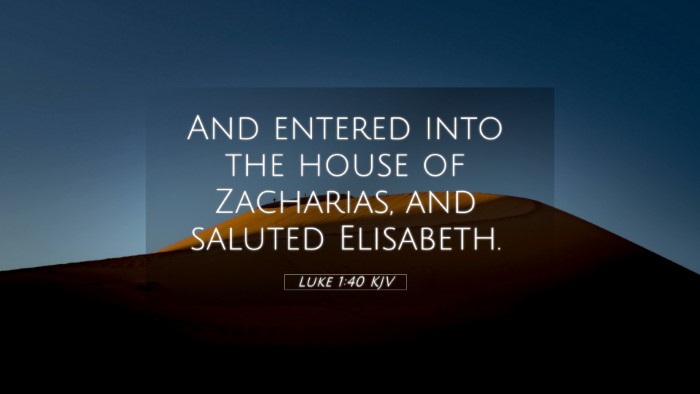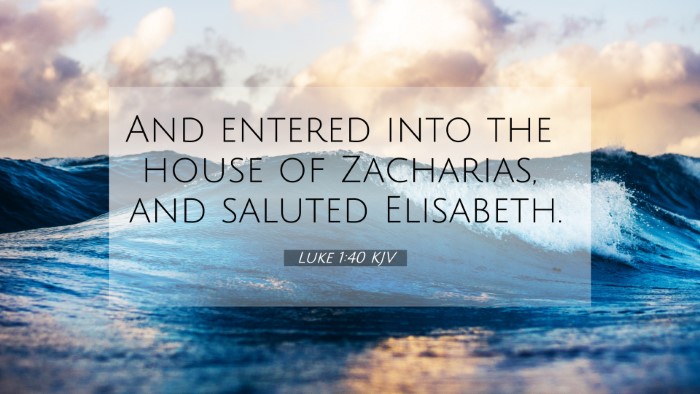Understanding Luke 1:40
Luke 1:40 reads: "And entered into the house of Zacharias, and saluted Elisabeth." This verse is part of the narrative that describes the visit of Mary, the mother of Jesus, to her relative Elisabeth, who was pregnant with John the Baptist. The significance of this visit unfolds through various commentaries. Below, we delve into the meanings drawn from esteemed public domain commentaries by Matthew Henry, Albert Barnes, and Adam Clarke.
Summary of Interpretations
Contextual Background
The context surrounding Luke 1:40 is rich with themes of divine intervention and the fulfillment of prophecy. This event occurs shortly after the Annunciation, where the angel Gabriel informs Mary of her impending virgin birth. Mary’s visit to Elisabeth illustrates her faith and obedience to God’s plan.
Matthew Henry's Commentary Insights
Matthew Henry emphasizes the humble visit of Mary as an act of love and compassion. He points out that Mary did not seek glory but rather wished to support her cousin. This action signifies the importance of community and familial support during challenging times. Furthermore, Henry highlights how their shared experience of miraculous pregnancies bonds them in a profound spiritual connection.
Albert Barnes' Commentary Insights
Albert Barnes expands on the significance of Mary’s greeting of Elisabeth. He notes that this event marks one of the first instances of the recognition of Jesus' divine nature. Elisabeth’s eventual declaration of Mary as "blessed among women" underscores the theme of humility and divine favor in God's plans. Barnes stresses that this visit serves to link both mothers in the purpose of God, showcasing the depth of their roles in the unfolding divine narrative.
Adam Clarke's Commentary Insights
Adam Clarke provides insight into the setting of the visit. He comments on the geographical and cultural aspects that may have influenced Mary’s journey. Clarke posits that Mary’s decision to visit Elisabeth reflects a deep theological understanding of her own situation and Elisabeth’s prophetic role. This interaction is a moment of mutual affirmation of faith and God's miraculous works.
Connections to Other Biblical Verses
Luke 1:40 is interconnected with several other verses throughout the Bible, emphasizing its themes and messages. Here are some notable cross-references:
- Matthew 1:23: The fulfillment of the prophecy concerning the virgin birth.
- Isaiah 7:14: The original prophecy regarding the birth of a child named Immanuel.
- Luke 1:36: The angel's announcement of Elisabeth's pregnancy.
- Luke 1:57-58: Elisabeth gives birth to John the Baptist, showcasing the miraculous nature of both pregnancies.
- John 1:30: John the Baptist's recognition of Jesus as the Lamb of God, indicating their divine connection.
- Matthew 5:12: The concept of rejoicing in the face of spiritual blessings, linking to the joy shared between Mary and Elisabeth.
- Galatians 4:4: The idea of God's timing and fulfillment of promises, resonating with the events of this passage.
Thematic Bible Verse Connections
The themes of divine providence, familial love, and prophetic fulfillment run strongly through Luke 1:40. This verse serves as a bridge linking Old Testament prophecies with New Testament revelations. Understanding these connections enriches the study of Scripture and encourages deeper reflection on God's overarching plan.
Comparative Bible Verse Analysis
When engaging in a comparative study, one might explore how this visit reflects other significant biblical encounters, such as:
- Mary and Martha (John 11:1-45): Exploring the theme of familial relationships.
- Ruth and Naomi (Ruth 1:16-18): The loyalty and support between family members.
- David and Jonathan (1 Samuel 18:1-4): Covenantal friendship and support.
Tools for Bible Cross-Referencing
To gain a more profound understanding of biblical texts like Luke 1:40, utilizing tools such as a Bible concordance or a cross-reference Bible study guide can be incredibly beneficial. These resources allow readers to explore connections and themes throughout the Scriptures, enhancing their study experience.
Conclusion
Luke 1:40 serves as a rich verse that embodies the intertwined lives of Mary and Elisabeth, set against the backdrop of divine promise and fulfillment. The insights provided by Matthew Henry, Albert Barnes, and Adam Clarke contribute to a deeper grasp of this significant biblical moment. By exploring its connections to various Bible verses and themes, readers can appreciate the cohesive narrative that Scripture presents.


